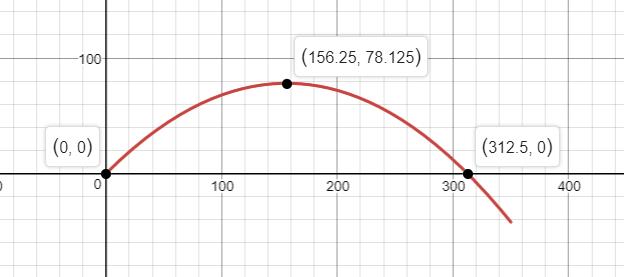
Concept explainers
Analyzing the Motion of a Projectile A projectile is fired at an inclination of to the horizontal, with a muzzle velocity of 100 feet per second. The height of the projectile is modeled by
where is the horizontal distance of the projectile from the firing point.
(a) At what horizontal distance from the firing point is the height of the projectile a maximum?
(b) Find the maximum height of the projectile.
(c) At what horizontal distance from the firing point will the projectile strike the ground?
(d) Using a graphing utility, graph the function .
(e) Use a graphing utility to verify the results obtained in parts (b) and (c).
(f) When the height of the projectile is 50 feet above the ground, how far has it traveled horizontally?
To calculate:
At what horizontal distance from the firing point is the height of the projectile a maximum?
Find the maximum height of the projectile?
At what horizontal distance from the firing point will the projectile strike the ground?
Graph the function , using a graphing utility .
Using graphing utility verify the solutions found in (b) and (c).
When the height of the projectile is 50 feet above the ground, how far is it travelled horizontally?
Answer to Problem 12AYU
Solution:
feet.
The projectile will strike the ground at a horizontal distance of ft and at the firing point.
The graph is given below.
The graph is given below.
When , we have and .
Explanation of Solution
Given:
A projectile is fired from an inclination of 45 degree to the horizontal, with a muzzle velocity of 100 feet per second. The height of the projectile above water is modelled by
, where is the horizontal distance of the projectile from the firing point.
Formula used:
For a quadratic equation , we have
Calculation:
a. The height of the projectile is a quadratic equation with . Since is negative, the vertex is the maximum of the given function. Therefore, the maximum is .
Thus, at , the height of the projectile is maximum.
b. The maximum height of the projectile is at
Thus, the maximum height of the projectile is feet.
c. Now, we need to find the value of at .
and
The projectile will strike the ground at a horizontal distance of ft and at the firing point.
d.
e. From the above graph, we can see that the answers in (b) and (c) are true.
f. Now, we have to find when .
and
When , we have and .
Chapter 3 Solutions
Precalculus Enhanced with Graphing Utilities
Additional Math Textbook Solutions
College Algebra with Modeling & Visualization (5th Edition)
Introductory Statistics
Basic Business Statistics, Student Value Edition
Elementary Statistics: Picturing the World (7th Edition)
Elementary Statistics
Elementary Statistics (13th Edition)
- For the system consisting of the lines: and 71 = (-8,5,6) + t(4, −5,3) 72 = (0, −24,9) + u(−1, 6, −3) a) State whether the two lines are parallel or not and justify your answer. b) Find the point of intersection, if possible, and classify the system based on the number of points of intersection and how the lines are related. Show a complete solution process.arrow_forward3. [-/2 Points] DETAILS MY NOTES SESSCALCET2 7.4.013. Find the exact length of the curve. y = In(sec x), 0 ≤ x ≤ π/4arrow_forwardH.w WI M Wz A Sindax Sind dy max Утах at 0.75m from A w=6KN/M L=2 W2=9 KN/m P= 10 KN B Make the solution handwritten and not artificial intelligence because I will give a bad rating if you solve it with artificial intelligencearrow_forward
- Solve by DrWz WI P L B dy Sind Ⓡ de max ⑦Ymax dx Solve by Dr ③Yat 0.75m from A w=6KN/M L=2 W2=9 kN/m P= 10 KN Solve By Drarrow_forwardHow to find the radius of convergence for the series in the image below? I'm stuck on how to isolate the x in the interval of convergence.arrow_forwardDetermine the exact signed area between the curve g(x): x-axis on the interval [0,1]. = tan2/5 secx dx andarrow_forward
 Calculus: Early TranscendentalsCalculusISBN:9781285741550Author:James StewartPublisher:Cengage Learning
Calculus: Early TranscendentalsCalculusISBN:9781285741550Author:James StewartPublisher:Cengage Learning Thomas' Calculus (14th Edition)CalculusISBN:9780134438986Author:Joel R. Hass, Christopher E. Heil, Maurice D. WeirPublisher:PEARSON
Thomas' Calculus (14th Edition)CalculusISBN:9780134438986Author:Joel R. Hass, Christopher E. Heil, Maurice D. WeirPublisher:PEARSON Calculus: Early Transcendentals (3rd Edition)CalculusISBN:9780134763644Author:William L. Briggs, Lyle Cochran, Bernard Gillett, Eric SchulzPublisher:PEARSON
Calculus: Early Transcendentals (3rd Edition)CalculusISBN:9780134763644Author:William L. Briggs, Lyle Cochran, Bernard Gillett, Eric SchulzPublisher:PEARSON Calculus: Early TranscendentalsCalculusISBN:9781319050740Author:Jon Rogawski, Colin Adams, Robert FranzosaPublisher:W. H. Freeman
Calculus: Early TranscendentalsCalculusISBN:9781319050740Author:Jon Rogawski, Colin Adams, Robert FranzosaPublisher:W. H. Freeman
 Calculus: Early Transcendental FunctionsCalculusISBN:9781337552516Author:Ron Larson, Bruce H. EdwardsPublisher:Cengage Learning
Calculus: Early Transcendental FunctionsCalculusISBN:9781337552516Author:Ron Larson, Bruce H. EdwardsPublisher:Cengage Learning





